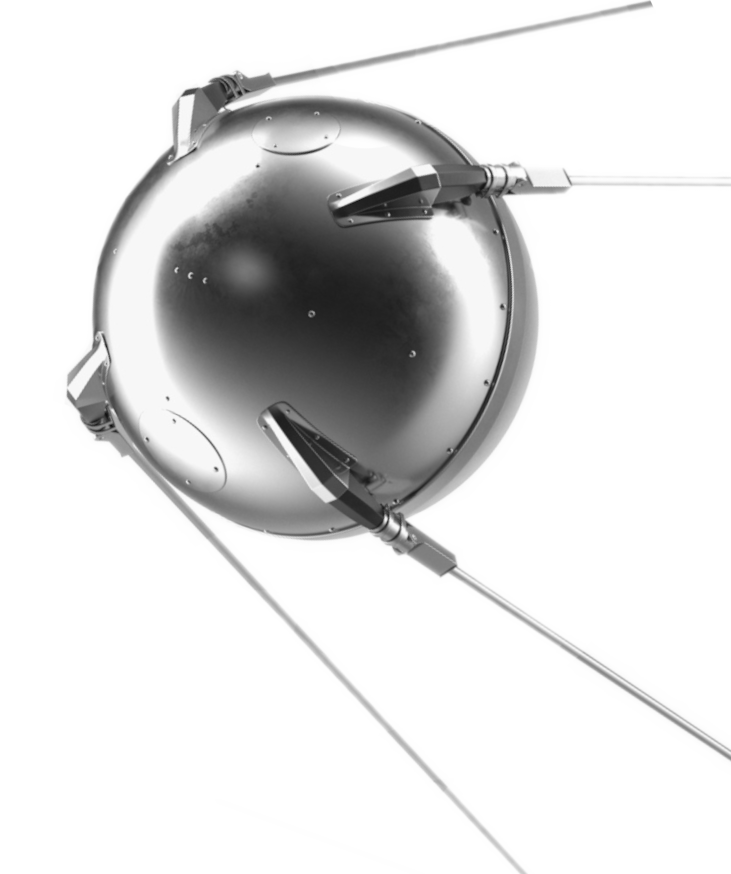 took great care in aligning a bilge’s parts, to make sure the final piece would come exactly to it designed shape, and to make sure the port and starboard bilges are identical, or else, the boat would have a twisted hull. All joints is slightly sanded, and applied a layer of glass on the internal side. Next come the job of putting everything together using a combination of fastening wires, super glue and duct tape. Having experiences from previous boat, I used very little steel wires this time.
took great care in aligning a bilge’s parts, to make sure the final piece would come exactly to it designed shape, and to make sure the port and starboard bilges are identical, or else, the boat would have a twisted hull. All joints is slightly sanded, and applied a layer of glass on the internal side. Next come the job of putting everything together using a combination of fastening wires, super glue and duct tape. Having experiences from previous boat, I used very little steel wires this time.
It’s so good to see the bilges fit naturally into their position, with minimum pressing, adjusting efforts. The tendency to take shape easily proves that you’ve all done right in the previous steps: measuring, drawing, cutting and jointing the biges. This is for the first time, you would have an initial impression, of how the boat would finally look like. The computer 3D renderings are too small to have a precise assessment, and of course, it’s always much more lively with a tangible object! 😀
Looking at these two halves: hull and deck, having a senses of every details, it’s easier to arrange and schedule the next tasks. There’re so many jobs ahead: make and install the (recessed) hatches, hatches’ locks, install the cockpit coaming, rudder pedals and control lines, compass, the bilge pump, etc… and of course the whole complex electric & electronic system. Things should be better done this time, with the lessons learnt (tediously and expensively) from previous boat projects.




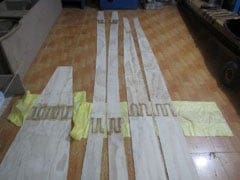
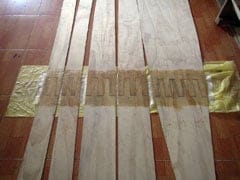
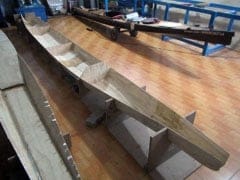
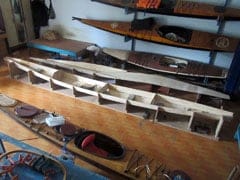
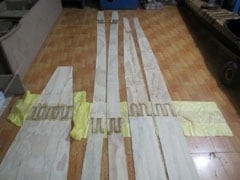
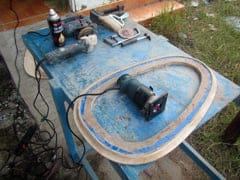
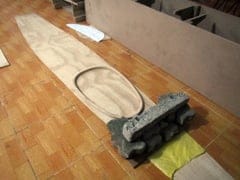
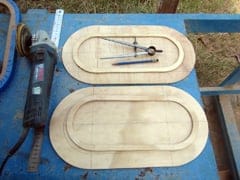
 ài trăm năm trước, Marx đã vẽ ra một cơn “ác mộng” về cuộc sống dưới chế độ TBCN, nơi mọi thứ sản xuất ra là để mua bán, đổi chác. Năng lực sáng tạo của con người bị biến thành một thứ hàng hoá. Sản phẩm và người làm ra sản phẩm rút cuộc cũng đều là một thứ hàng hoá, và cuộc sống hàng ngày bị biến thành một vòng xoáy bất tận.
ài trăm năm trước, Marx đã vẽ ra một cơn “ác mộng” về cuộc sống dưới chế độ TBCN, nơi mọi thứ sản xuất ra là để mua bán, đổi chác. Năng lực sáng tạo của con người bị biến thành một thứ hàng hoá. Sản phẩm và người làm ra sản phẩm rút cuộc cũng đều là một thứ hàng hoá, và cuộc sống hàng ngày bị biến thành một vòng xoáy bất tận. ext is jointing the plywood pieces: 8 joints for the hull, and just 1 for the deck, to form the bilges that would build up into the boat shape. For the 2 pairs of hull’s bilges, I flip one pair by 180 degree when drawing on the boards, so that to distribute the joints at different places across the boat length, and not to concentrate too much joints into one proximity. That old boatbuilding carpenter’s trick is not completely necessary with modern building techniques, but it’s nice to do so anyway.
ext is jointing the plywood pieces: 8 joints for the hull, and just 1 for the deck, to form the bilges that would build up into the boat shape. For the 2 pairs of hull’s bilges, I flip one pair by 180 degree when drawing on the boards, so that to distribute the joints at different places across the boat length, and not to concentrate too much joints into one proximity. That old boatbuilding carpenter’s trick is not completely necessary with modern building techniques, but it’s nice to do so anyway.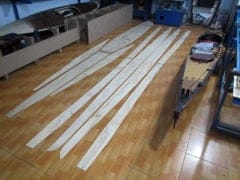
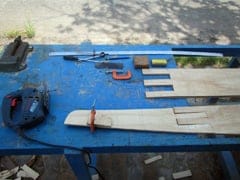
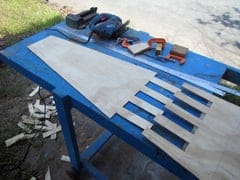
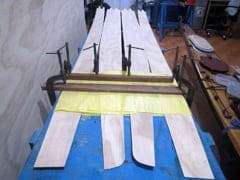
 he progress is really slow lately, several weeks passed, but little get done 😢! Things started moving anyhow, I “quickly” transfer the “offset tables” onto the plywood boards, draw all the bilges, bulkheads, and other parts. The greatest thing of all is that now I’ve purchased very good sheets of plywood, not truly marine – grade (there’s no such in Vietnam), but high – grade water – resistance ones. I could feel it when do the sawing, the boards are quit tough, not fragile as with my previous ply!
he progress is really slow lately, several weeks passed, but little get done 😢! Things started moving anyhow, I “quickly” transfer the “offset tables” onto the plywood boards, draw all the bilges, bulkheads, and other parts. The greatest thing of all is that now I’ve purchased very good sheets of plywood, not truly marine – grade (there’s no such in Vietnam), but high – grade water – resistance ones. I could feel it when do the sawing, the boards are quit tough, not fragile as with my previous ply!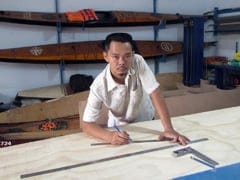
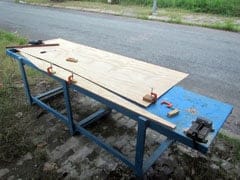
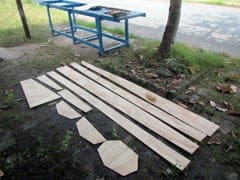
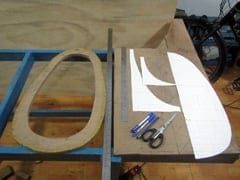
 ver the years of designing and building wooden kayak, often a recurring question comes to my mind: how can we precisely construct a kayak cockpit shape in a mathematical way. Today, I spent 30 minutes to figure out the problem, it turned out to be quite easy indeed. But first of all, there are so many different shapes for cockpits, and everyone may have his / her own preference on how it should look like. Here I try to plot a shape that is most suited to my eyes, and closed to what’s usually called “an ocean cockpit” found on Greenland kayaks.
ver the years of designing and building wooden kayak, often a recurring question comes to my mind: how can we precisely construct a kayak cockpit shape in a mathematical way. Today, I spent 30 minutes to figure out the problem, it turned out to be quite easy indeed. But first of all, there are so many different shapes for cockpits, and everyone may have his / her own preference on how it should look like. Here I try to plot a shape that is most suited to my eyes, and closed to what’s usually called “an ocean cockpit” found on Greenland kayaks.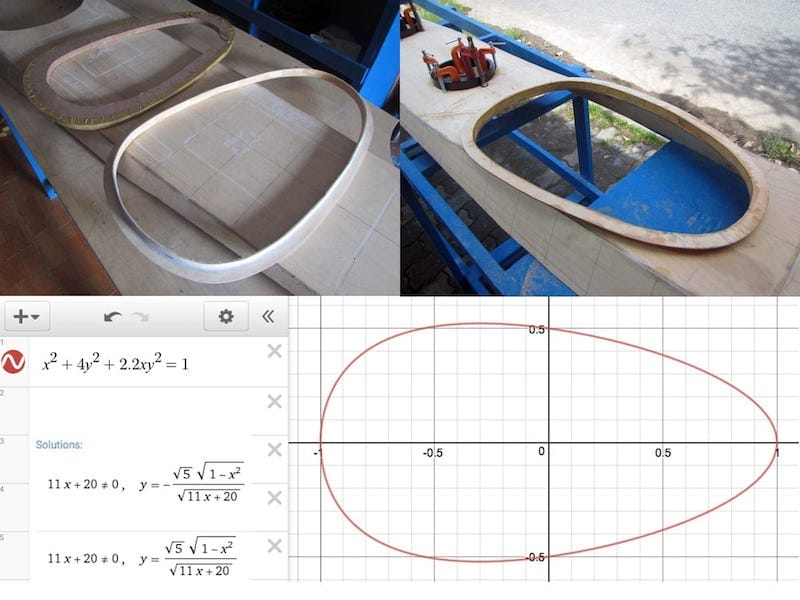
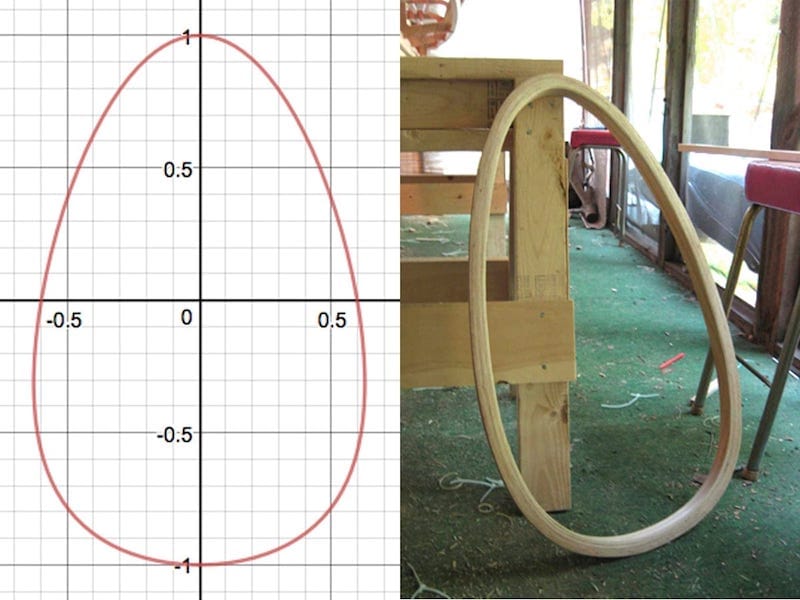
 i cũng biết bài hát xưa như trái đất này, nhưng mấy người biết nó nói về cái gì!? “The final count down” – lệnh đếm ngược: 9, 8, 7… 3, 2, 1… Preliminary stage, Intermediate, Main, Lift – off… đọc lời bài hát sẽ rõ, ngồi trên hàng trăm tấn thuốc nổ, trong một tích tắc là đi vào lịch sử (hoặc trở về với cát bụi) 😅
i cũng biết bài hát xưa như trái đất này, nhưng mấy người biết nó nói về cái gì!? “The final count down” – lệnh đếm ngược: 9, 8, 7… 3, 2, 1… Preliminary stage, Intermediate, Main, Lift – off… đọc lời bài hát sẽ rõ, ngồi trên hàng trăm tấn thuốc nổ, trong một tích tắc là đi vào lịch sử (hoặc trở về với cát bụi) 😅 ột chủ đề ưa thích của tôi là lịch sử Khoa học Kỹ thuật. Lên Đại học, tiếp xúc với các khái niệm automata, tự động hoá và điều khiển, tôi được học chung về các nguyên tắc đầu vào và đầu ra của các hệ thống máy tính điện tử. Tất cả các tín hiệu “in và out” (sensor, control, actuator…) được “lượng hoá” từ tín hiệu analog thành digital, vì máy tính hoạt động trên nguyên tắc tín hiệu số, dĩ nhiên có một số bộ chuyển đổi AD, DA ở đâu đó. Nhưng mãi lâu về sau, tôi mới được biết đến cái gọi là “analog computer”, ngược hẳn với “digital computer”, đó là những “máy tính tương tự”, hoạt động trên các “tín hiệu tương tự”, sử dụng những nguyên tắc cơ, điện, quang là chủ yếu. Một ví dụ “kinh khủng” nhất cho các “analog computer” loại này là các “máy tính” sử dụng trong điều khiển tàu vũ trụ của Liên Xô, mở ra bên trong thấy toàn các bánh xe cơ giới!
ột chủ đề ưa thích của tôi là lịch sử Khoa học Kỹ thuật. Lên Đại học, tiếp xúc với các khái niệm automata, tự động hoá và điều khiển, tôi được học chung về các nguyên tắc đầu vào và đầu ra của các hệ thống máy tính điện tử. Tất cả các tín hiệu “in và out” (sensor, control, actuator…) được “lượng hoá” từ tín hiệu analog thành digital, vì máy tính hoạt động trên nguyên tắc tín hiệu số, dĩ nhiên có một số bộ chuyển đổi AD, DA ở đâu đó. Nhưng mãi lâu về sau, tôi mới được biết đến cái gọi là “analog computer”, ngược hẳn với “digital computer”, đó là những “máy tính tương tự”, hoạt động trên các “tín hiệu tương tự”, sử dụng những nguyên tắc cơ, điện, quang là chủ yếu. Một ví dụ “kinh khủng” nhất cho các “analog computer” loại này là các “máy tính” sử dụng trong điều khiển tàu vũ trụ của Liên Xô, mở ra bên trong thấy toàn các bánh xe cơ giới!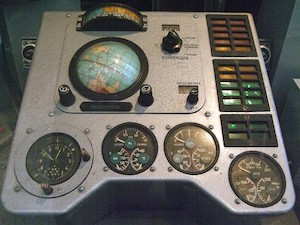
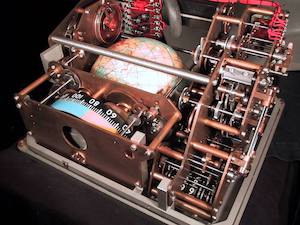
 ạn chưa hiểu được lý do của tội ác cho đến khi bạn chứng kiến một tội ác hoàn toàn chẳng có lý do nào! Nó để lại những câu hỏi không có lời giải đáp, về những góc khuất đen tối trong tâm hồn con người!
ạn chưa hiểu được lý do của tội ác cho đến khi bạn chứng kiến một tội ác hoàn toàn chẳng có lý do nào! Nó để lại những câu hỏi không có lời giải đáp, về những góc khuất đen tối trong tâm hồn con người! 